 |
–The following are based on posters presented at the 12th European Congress of Clinical Microbiology and Infectious Diseases held April 24-27, 2002, in Milan, Italy.
Epidemiology of Pneumocystis carinii Dihydropteroate Synthase Mutations Associated With Drug Resistance
Based on a poster presented by Nahimana A,* Rabodonirina M,† Francioli P,* Blanc DS,* Picot S,† Bille J,‡ Weber A,§ Hauser P*
*Hospital Preventive Medicine, Centre Hospitalier Universitaire Vaudois, Lausanne, Switzerland; †Service de Parisitologie Mycologie, Hôpital Edouard-Herriot, Lyon, France; ‡Microbiology Institute, Centre Hospitalier Universitaire Vaudois, Lausanne, Switzerland; §University Hospital, Zurich, Switzerland
Pneumocystis carinii is a fungus that causes severe pneumonia (PCP) in immunocompromised patients, most commonly those infected with the human immunodeficiency virus. Sulfa drugs are often used to prevent and treat PCP. Recently, the use of these drugs was shown to be associated with 2 mutations that alter the active site of dihydropteroate synthase (DHPS), the target of sulfa therapy. These mutations result in an amino acid change at position 55 (M1) or position 57 (M2), as either a single or double mutation (M3) in the same isolate.
In studying the epidemiology of the DHPS gene mutations of P carinii, the investigators developed and used a rapid and simple method to discriminate between the DHPS genotypes: polymerase chain reaction—single-strand conformation polymorphism (PCR-SSCP), which consists of amplification of the DHPS gene by PCR, followed by the detection of its polymorphism using the SSCP technique. PCR-SSCP was applied to bronchoalveolar lavage specimens obtained from 397 patients: 189 from 5 hospitals in Lyon, France; 152 from Lausanne University Hospital in Switzerland; and 56
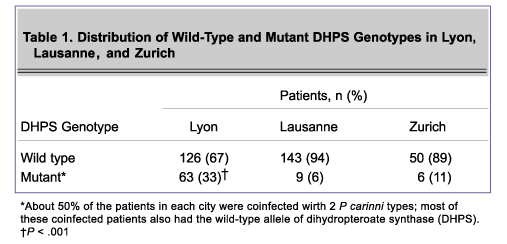
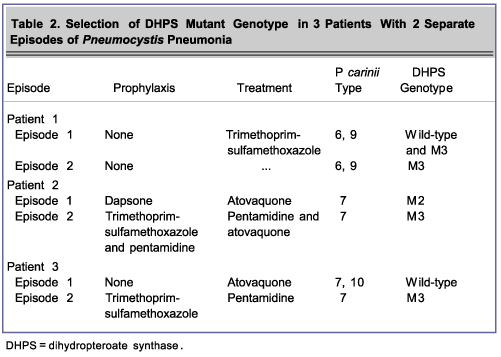
from Zurich University Hospital in Switzerland. Four DHPS genotypes were found. The distribution of wild-type and mutant DHPS genotypes in 3 cities is shown in Table 1. The frequency of mutant genotypes was significantly higher in the patients of Lyon.
The prophylactic use of sulfadoxine (as part of combined sulfadoxine-pyrimethamine) in 3 of the hospitals in Lyon was associated with DHPS mutant genotype M2. In the other 2 hospitals in Lyon where sulfamethoxazole was given (as part of combined trimethoprim-sulfamethoxazole) as prophylaxis, the M3 genotype was most common.
The investigators also analyzed DHPS genotypes in 3 patients from Lyon, each of whom had 2 separate PCP episodes that were caused by the same P carinii type more than 3 months apart (Table 2). Because all 3 patients received trimethoprim-sulfamethoxazole either as treatment or prophylaxis, and because all 3 harbored the M3 mutant in the second episode, the findings suggest that selection of the DHPS mutant genotype occurred as a result of sulfamethoxazole therapy within each patient.
Evaluation of the in Vitro Activity of Caspofungin Against Invasive Candida From Cancer Patients: Comparison of E-Test and NCCLS Methods
Based on a poster presented by Laverdière M, Restieri C, Habel F
Department of Microbiology and Infectious Diseases, Hôpital Maisonneuve Rosemont, Montreal, Quebec, Canada
The emergence of non-Candida albicans infections and increasing resistance to azole-based antifungal agents have changed the pattern of invasive fungal infections usually seen in cancer patients. These changes,which underscore the need to consider or develop other antifungal agents, prompted the investigators to compare the in vitro activity of caspofungin, fluconazole, itraconazole, and amphotericin B with 178 fungemic yeasts recovered from cancer patients at the Hôpital Maisonneuve Rosemont in Montreal between 1997 and 2001.
To compare the in vitro activity of these 4 agents, the investigators used 2 different susceptibility testing methods: the E test, a diffusion method consisting of a strip with a gradient of drug concentrations that permits easy and rapid reading of minimum inhibitory concentration (MIC) values, and the broth dilution M27A reference method established by the National Committee for Clinical Laboratory Standards (NCCLS). The comparative MIC90 values for each of the 4 agents obtained by both testing methods are shown in the Table.
The percentages of agreement within 2 dilutions between the NCCLS reference method and the E test were 81% for itraconazole, 82% for fluconazole, 84% for caspofungin, and 97% for amphotericin B. As the investigators point out, the results demonstrate that caspofungin, an echinocandin, is active against invasive Candida in cancer patients.
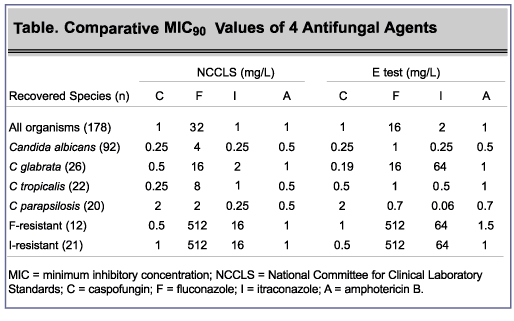
Fungemia in Patients at a University Hospital: Impact of Concurrent Infections, Cancer, Coronary Artery Disease, Diabetes, and Renal Failure on Mortality
Based on a poster presented by Safdar A, Bannister TW Palmetto-Health Richland Hospital and University of South Carolina School of Medicine, Columbia, South Carolina
In a study to determine the association of host factors and nosocomial interventions with outcome in patients who developed fungemia, hematogenous candidiasis was found to be a serious and often fatal complication, even in immunocompetent individuals.
Between January 1, 1998, and December 31, 1999, 81 consecutive episodes of fungemia in 75 hospitalized patients were evaluated retrospectively for 1) the presence of concurrent infections and medical conditions; 2) the circumstances under which the fungemia developed; 3) the Candida species causing the fungemia; 4) the antibiotic therapy given; and 5) short-term mortality.
Regarding concurrent infections and medical conditions, 18 of the patients had an underlying solid-organ malignancy; 16 had an underlying hematologic malignancy (9 of whom received an allogeneic bone marrow transplant); 8 were neutropenic; 45 had fever above 100.5°F; 25 had no fever; 16 had coronary artery disease; 14 had renal failure (7 with acute azotemia, 6 undergoing hemodialysis); 13 had diabetes; 2 had pancreatitis; and 4 had cirrhosis of the liver. Many of the 75 patients who developed fungemia had more than 1 concurrent infection or condition.
Mortality was defined as death during the course of antifungal therapy and/or within 30 days of the last positive blood culture during the same hospitalization. Mortality for each of these concurrent infections and conditions is shown in Table 1. Overall mortality was 44.3%.
During this study, 2 patients with acquired immune deficiency syndrome, 3 patients with short bowel syndrome, and 11 infants (9 premature) developed fungemia, yet none of them died. This is an encouraging finding, as fungemia is common in immunocompromised patients and associated with considerable mortality. Surprisingly, there was a high mortality rate in immunocompetent patients, particularly those with coronary artery disease or acute azotemia.
Fungemia developed during hyperalimentation and following surgery. Of the 47 patients who developed fungemia while they were receiving hyperalimentation, 23 died. Overall mortality was 40% regarding 42 patients who developed fungemia following surgery. Of these patients, 22 had undergone abdominal and/or pelvic surgery, 6 had undergone vascular surgery, and 7 required surgery for severe trauma. Mortality for these 3 groups was 40%, 33%, and 43%, respectively.
Most of the 81 episodes of fungemia were caused by Candida albicans (37%), C glabrata (31%), and C parapsilosis (17%). Except for the single episode caused by C lusitaniae, which resulted in death, mortality from infection with C glabrata was significantly higher (P < .01) than that associated with other Candida species (Table 2).
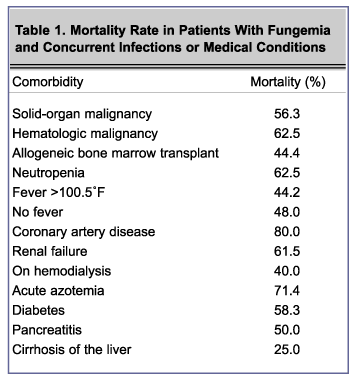
Of the 60 patients who received antibiotics within 30 days of bloodstream invasion, 26 died. Similarly, of the 22 patients who received antifungal agents, 12 died, with a mortality rate of 57% in those receiving tirazole-based agents, 75% in those receiving amphotericin B, and 75% in those receiving 2 antifungal agents.
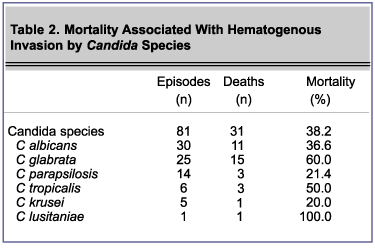
Invasive Aspergillosis in Solid-Organ Transplantation:
Report of 8 Cases
Based on a poster presented by Arslan H, Ergin F, Kuru Inci E, Demirhan B, Karakayali H, Haberal M
Department of Infectious Diseases and Clinical Microbiology, Baskent University Medical School, Ankara, Turkey
The high mortality rate in patients with invasive aspergillosis underscores the importance of prompt diagnosis and treatment. Moreover, when the infection occurs in high-risk solid-organ transplant recipients, it should always be considered life threatening; treatment should be initiated as soon as specimens have been obtained for microbiologic testing.
These points are well illustrated by findings from a series of 8 patients who developed invasive aspergillosis after receiving kidney (n = 4) or liver (n = 4) transplants. All 8 patients were men, with a mean age of 38 years (range, 22—55 years). Mean time from organ transplantation to diagnosis of invasive aspergillosis was 24 days (range, 15—34 days). All patients received various combinations of prednisolone, cyclosporine, mycophenolate-mofetil, azathioprine, and tacrolimus.
A retrospective evaluation of clinical and laboratory findings revealed that 6 patients had fever, 5 had a productive cough with sputum and dyspnea, 1 had unexplained diarrhea, and all 8 patients had evidence of pneumonic infiltration or nodular involvement on chest radiography. Computed tomography scans of the thorax revealed bronchopneumonia, nodular, and nodular and cavitation patterns. Definitive diagnosis was based on isolation of Aspergillus fumigatus from cultures of bronchoalveolar lavage fluid and sputum in 2 patients, bronchial biopsy in 1 patient, and at autopsy in 5 of the 6 patients who died.
Risk factors for the development of invasive aspergillosis in these transplant recipients were acute rejection (n = 4), long-term antibiotic therapy (n = 4), muromonab-CD3 treatment (n = 3), thrombocytopenia (n = 3), and repeated transplantation (n = 1).
Four patients who received a diagnosis of invasive aspergillosis before they died were treated with liposomal amphotericin B at a dose of 5 mg/kg daily. Two patients whose clinical and laboratory findings strongly suggested invasive aspergillosis were treated empirically with amphotericin B at a dose of 3 mg/kg daily, with the diagnosis confirmed at autopsy. Of 5 patients who were diagnosed at autopsy, 2 did not receive antifungal therapy before they died.
Two patients in this series were eventually discharged from the hospital, 1 after 21 days of therapy with amphotericin B and 14 days of therapy with itraconazole, and the other after 21 days of therapy with amphotericin B alone.
Volume 3, Number 1A - January 2003
This CME Expires on January 15, 2005; no tests will be accepted after this date.
This course is accredited by
Johns Hopkins University School of Medicine Advanced Studies in Medicine
|
 |

